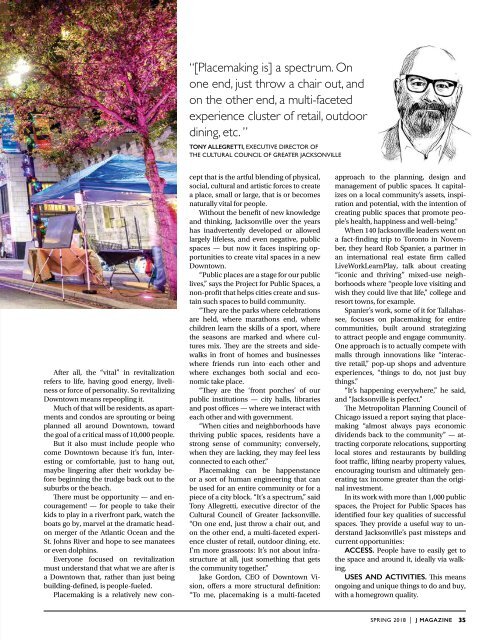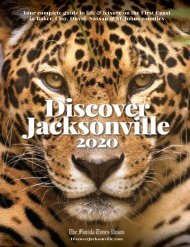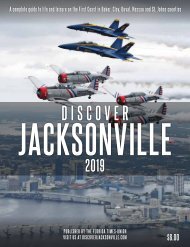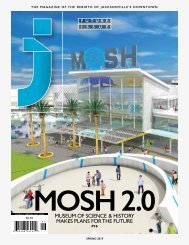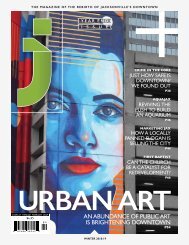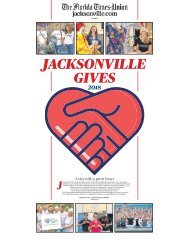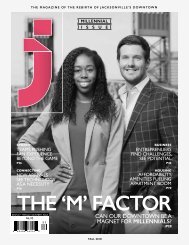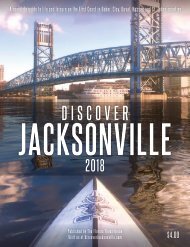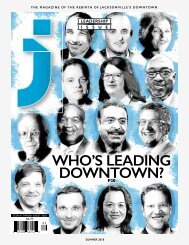J Magazine Spring 2018
Create successful ePaper yourself
Turn your PDF publications into a flip-book with our unique Google optimized e-Paper software.
“[Placemaking is] a spectrum. On<br />
one end, just throw a chair out, and<br />
on the other end, a multi-faceted<br />
experience cluster of retail, outdoor<br />
dining, etc. ”<br />
Tony Allegretti, executive director of<br />
the Cultural Council of Greater Jacksonville<br />
After all, the “vital” in revitalization<br />
refers to life, having good energy, liveliness<br />
or force of personality. So revitalizing<br />
Downtown means repeopling it.<br />
Much of that will be residents, as apartments<br />
and condos are sprouting or being<br />
planned all around Downtown, toward<br />
the goal of a critical mass of 10,000 people.<br />
But it also must include people who<br />
come Downtown because it’s fun, interesting<br />
or comfortable, just to hang out,<br />
maybe lingering after their workday before<br />
beginning the trudge back out to the<br />
suburbs or the beach.<br />
There must be opportunity — and encouragement!<br />
— for people to take their<br />
kids to play in a riverfront park, watch the<br />
boats go by, marvel at the dramatic headon<br />
merger of the Atlantic Ocean and the<br />
St. Johns River and hope to see manatees<br />
or even dolphins.<br />
Everyone focused on revitalization<br />
must understand that what we are after is<br />
a Downtown that, rather than just being<br />
building-defined, is people-fueled.<br />
Placemaking is a relatively new concept<br />
that is the artful blending of physical,<br />
social, cultural and artistic forces to create<br />
a place, small or large, that is or becomes<br />
naturally vital for people.<br />
Without the benefit of new knowledge<br />
and thinking, Jacksonville over the years<br />
has inadvertently developed or allowed<br />
largely lifeless, and even negative, public<br />
spaces — but now it faces inspiring opportunities<br />
to create vital spaces in a new<br />
Downtown.<br />
“Public places are a stage for our public<br />
lives,” says the Project for Public Spaces, a<br />
non-profit that helps cities create and sustain<br />
such spaces to build community.<br />
“They are the parks where celebrations<br />
are held, where marathons end, where<br />
children learn the skills of a sport, where<br />
the seasons are marked and where cultures<br />
mix. They are the streets and sidewalks<br />
in front of homes and businesses<br />
where friends run into each other and<br />
where exchanges both social and economic<br />
take place.<br />
“They are the ‘front porches’ of our<br />
public institutions — city halls, libraries<br />
and post offices — where we interact with<br />
each other and with government.<br />
“When cities and neighborhoods have<br />
thriving public spaces, residents have a<br />
strong sense of community; conversely,<br />
when they are lacking, they may feel less<br />
connected to each other.”<br />
Placemaking can be happenstance<br />
or a sort of human engineering that can<br />
be used for an entire community or for a<br />
piece of a city block. “It’s a spectrum,” said<br />
Tony Allegretti, executive director of the<br />
Cultural Council of Greater Jacksonville.<br />
“On one end, just throw a chair out, and<br />
on the other end, a multi-faceted experience<br />
cluster of retail, outdoor dining, etc.<br />
I’m more grassroots: It’s not about infrastructure<br />
at all, just something that gets<br />
the community together.”<br />
Jake Gordon, CEO of Downtown Vision,<br />
offers a more structural definition:<br />
“To me, placemaking is a multi-faceted<br />
approach to the planning, design and<br />
management of public spaces. It capitalizes<br />
on a local community’s assets, inspiration<br />
and potential, with the intention of<br />
creating public spaces that promote people’s<br />
health, happiness and well-being.”<br />
When 140 Jacksonville leaders went on<br />
a fact-finding trip to Toronto in November,<br />
they heard Rob Spanier, a partner in<br />
an international real estate firm called<br />
LiveWorkLearnPlay, talk about creating<br />
“iconic and thriving” mixed-use neighborhoods<br />
where “people love visiting and<br />
wish they could live that life,” college and<br />
resort towns, for example.<br />
Spanier’s work, some of it for Tallahassee,<br />
focuses on placemaking for entire<br />
communities, built around strategizing<br />
to attract people and engage community.<br />
One approach is to actually compete with<br />
malls through innovations like “interactive<br />
retail,” pop-up shops and adventure<br />
experiences, “things to do, not just buy<br />
things.”<br />
“It’s happening everywhere,” he said,<br />
and “Jacksonville is perfect.”<br />
The Metropolitan Planning Council of<br />
Chicago issued a report saying that placemaking<br />
“almost always pays economic<br />
dividends back to the community” — attracting<br />
corporate relocations, supporting<br />
local stores and restaurants by building<br />
foot traffic, lifting nearby property values,<br />
encouraging tourism and ultimately generating<br />
tax income greater than the original<br />
investment.<br />
In its work with more than 1,000 public<br />
spaces, the Project for Public Spaces has<br />
identified four key qualities of successful<br />
spaces. They provide a useful way to understand<br />
Jacksonville’s past missteps and<br />
current opportunities:<br />
Access. People have to easily get to<br />
the space and around it, ideally via walking.<br />
Uses and activities. This means<br />
ongoing and unique things to do and buy,<br />
with a homegrown quality.<br />
SPRING <strong>2018</strong> | J MAGAZINE 35


